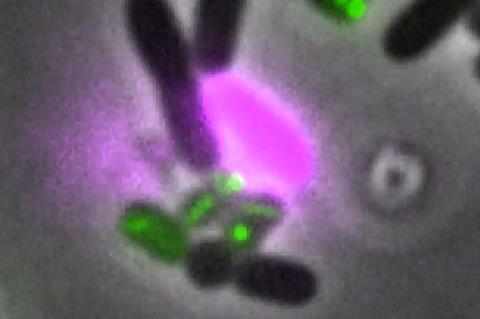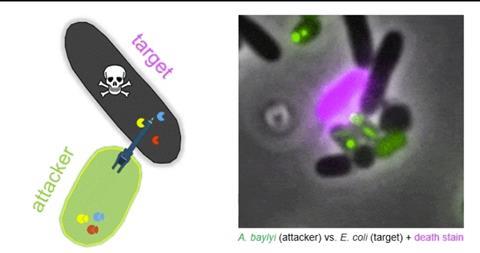Friendly germs armed with their own biological syringes and poisons could hold the key to overcoming the antimicrobial resistance crisis, according to a new study by biologists at the Universities of Manchester and Basel.

The study of special bacteria, which have evolved nanoscopic syringes –Type 6 Secretion Systems (T6SSs) – that inject cocktails of deadly toxins into rival microorganisms, is published in the journal PNAS.
Microbes been fighting their own wars on germs for millions of years – battling for survival against each other.
Toxin cocktails
The new Wellcome Trust-funded research shows that toxin cocktails used in these fights have a highly valuable property – they limit resistance evolution to T6SS attacks.
In both computer simulations and lab experiments, the researchers found that microbes readily evolved resistance to individual T6SS toxins, but that resistance did not occur when the toxins were injected together.
That means multi-toxin T6SSs might be ideal candidates for resistance-busting antimicrobials of the future.
T6SS-armed bacteria are already being harnessed as antimicrobials, with applications in crop protection or aquafarming.
Living biotherapeutics
Attacker bacteria could also be engineered as “living biotherapeutics”, targeting drug-resistant bacteria or fungi inside hosts.
READ MORE: Gut bacteria transfer genes to disable weapons of their competitors
READ MORE: Pathogens deploy speargun nanomachine to spread unrecognized in the body
The new results could now be used to improve these technologies,using toxin combinations to limit resistance evolution and extend their lifespan.
The work also suggests that microbes themselves might have much to teach us when it comes to overcoming resistance.
Millions of years
While the idea of combination therapy – using multiple toxins together to prevent resistance – dates from the 1950s, bacteria seem have been beaten humans to the discovery.

“Bacteria have been using T6SSs to attack other microbes for millions of years, and have developed their own type of combination therapy – injecting a range of toxin types together,” said lead author, Dr Will Smith, from the University of Manchester.
“It’s possible this evolved to limit resistance in competitors. If so, what other mechanisms might microbes have to do this?
“It’s an exciting prospect that we might make better antimicrobial therapies by consulting our top microbial assassins: the germs themselves.”







No comments yet